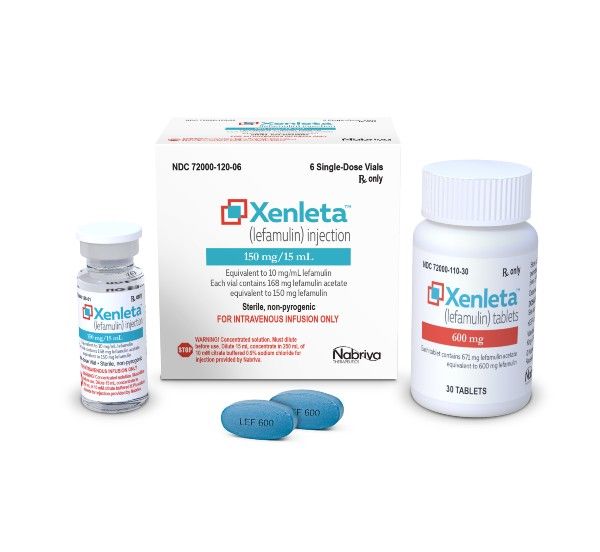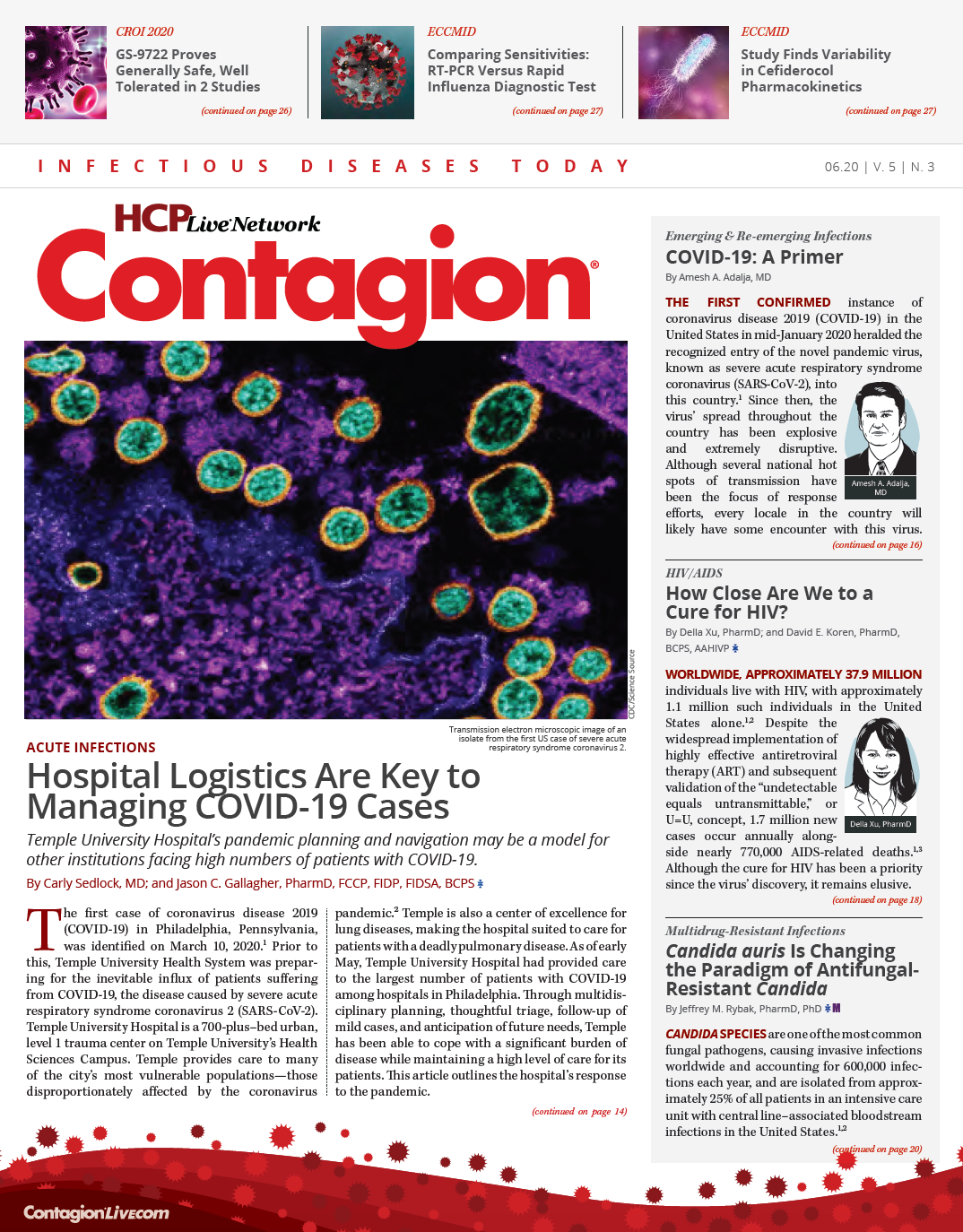Lefamulin: An Overview of a Lonely Soldier
Lefamulin, a recently approved pleuromutilin, adds to the current antibiotic armamentarium, although its place in therapy remains to be seen.

The pleuromutilin class of antibiotics has been a veter­inary medicine staple for decades. These antibiotics have a unique mechanism of action that provides a high barrier to resistance.1 Lefamulin (Xenleta) is the first systemic pleuromutilin antibiotic available for human use. The FDA approved it in August 2019 for the treatment of community-acquired bacterial pneumonia (CABP). Lefamulin is available for intravenous and oral administration dosed at 150 mg intravenously every 12 hours or 600 mg by mouth every 12 hours for a minimum of 5 days.2
MECHANISM OF ACTION
Lefamulin inhibits bacterial protein synthesis by binding to the 50S subunit at the peptidyl transferase center, thereby preventing peptide bond formation.1,3,4 Its novel mechanism includes binding to the target site through an induced-fit mechanism in which the binding pocket closes around itself, giving it a tight bind to the ribosome.1 Because of this unique mechanism, the probability of cross-resistance with other antibiotic classes is low, and it has a higher barrier of resistance by overcoming bacterial ribosomal mutations.5,6 The C14 side chain is responsible for the optimal properties of the drug, including solubility, broad spectrum of activity, and pharmacokinetics.1
SPECTRUM OF ACTIVITY
Lefamulin demonstrates potent in vitro activity against many common respiratory and skin pathogens, including gram-positive (except Enterococcus faecalis), fastid­ious (ie, Chlamydophila spp), and atypical gram-negative organisms.1,7,8 It is active against methicillin-resistant Staphylococcus aureus (MRSA), vancomycin-intermediate S aureus, vancomycin-resistant S aureus, and Enterococcus faecium, including vancomycin-resistant isolates. Compared with other common CABP antibiotics, lefamulin was the most potent against Streptococcus pneumoniae.1,8,9 It has reliable Haemophilus influenzae and Moraxella catarrh­alis activity, including β-lactamase—positive strains.8 Lastly, it is active against Neisseria gonorrhoeae, including multi­drug-resistant (MDR) and extensively drug-resistant (XDR) species.10 Notably, it has no reliable activity against other gram-negative organisms because of the presence of AcrAB-TolC efflux pumps.1
COMMUNITY-ACQUIRED BACTERIAL PNEUMONIA
Lefamulin has excellent penetration into epithelial lining fluid and reaches high intracellular concentrations.11,12 The efficacy and safety of lefamulin for CABP were established by 2 phase 3 studies, both of which were multicenter, multinational, randomized, and double-blind with a nonin­ferior design. The LEAP trial (NCT02559310) evaluated lefamulin versus moxifloxacin with and without linezolid (if evidence of MRSA) in adults with moderate to severe CABP for 7 days.13 Investigators randomized 551 patients 1:1 (276, lefamulin; 275, moxifloxacin). Patients started both agents as intravenous therapy, with the ability to switch to oral by day 3. Investigators found lefamulin to be noninfe­rior to moxifloxacin for early clinical response, which was the primary outcome (87.3% vs 90.2%, respectively), as well as assessment of clinical response (81.7% vs 84.2%). Diarrhea was more common in the moxifloxacin group compared with the lefamulin group (7.7% vs 0.7%, respectively; P <.001). Rates of study drug discontinua­tion due to treatment-emergent adverse events (AEs) were 2.9% for lefamulin and 4.4% for moxifloxacin.13
The LEAP2 trial (NCT02813694) evaluated oral lefamulin for 5 days versus oral moxifloxacin for 7 days for CABP.14 Investigators randomized 738 patients 1:1 (370, lefamulin; 368, moxifloxacin), and 707 completed the trial. In the microbiologically evaluable patients, the most commonly isolated pathogen was S pneumoniae. Although about half of patients had microbiologic data, investigators used nonculture methods, which limited the ability to obtain minimum inhibitory concentration data. The early clin­ical response rate at 96 hours in the intention-to-treat population (primary end point) was 90.8% with lefamulin versus 90.8% with moxifloxacin. This demonstrated nonin­feriority of 5 days of lefamulin to 7 days of moxifloxacin. Treatment-emergent AEs occurred in 32.6% of patients taking lefamulin and 25.0% of those taking moxifloxacin. More patients in the lefamulin arm experienced gastro­intestinal (GI) intolerances (17.9% vs 7.6%, respectively), particularly diarrhea. Drug discontinuation occurred in 12 (3.3%) patients taking lefamulin and 9 (2.4%) taking moxifloxacin.14
ACUTE BACTERIAL SKIN AND SKIN STRUCTURE INFECTIONS
Lefamulin’s activity against common skin pathogens, avail­ability of oral administration, and high concentration in adipose and skeletal muscle tissue make it an appealing treatment option for acute bacterial skin and skin struc­ture infections (ABSSSIs). In a phase 2 double-blind, parallel-group study, investigators randomized 210 hospi­talized adult patients with an ABSSSI to receive lefamulin 100 mg, lefamulin 150 mg, or vancomycin via intrave­nous infusion for 5 to 14 days.15 Of the 186 patients who completed the study, clinical success at the test-of-cure visit was similar among those receiving lefamulin 100 mg, lefamulin 150 mg, and vancomycin (90.0%, 88.9%, and 92.2%, respectively). In the presence of Panton- Valentine leucocidin—positive S aureus, lefamulin showed success rates similar to those of vancomycin. Lefamulin was well tolerated at both doses, with the most frequently reported AEs being GI in nature.15 No ongoing phase 3 studies are evaluating lefamulin for this indication, but it has a promising role for ABSSSI.
SEXUALLY TRANSMITTED INFECTIONS
Lefamulin has excellent genitourinary penetration, including into prostate and pelvic tissues.16 In vitro data suggest activity against common sexually transmitted infection (STI) pathogens, including drug-resistant strains of Mycobacterium genitalium and N gonorrhoeae, with no evidence of cross-resistance.7,13 It demonstrated a 5-fold greater potency compared with azithromycin in Chlamydia trachomatis.16 In 117 gonococcal isolates that were MDR or XDR, lefamulin showed reliable activity.10 Of note, the presence of the MtrCDE efflux pump, which is responsible for enhancing N gonorrhoeae survival through a variety of factors including drug efflux, did influence lefamulin susceptibility.6,8 This warrants further exploration.
ADVERSE REACTIONS, WARNINGS, AND PRECAUTIONS
Although lefamulin was generally well tolerated in clin­ical studies, GI AEs including nausea and diarrhea were frequently reported. Diarrhea was less common than with moxifloxacin in LEAP, but the opposite held true in LEAP2.13,14 GI AEs are most notable when initiating oral lefamulin, and clinicians should counsel patients accord­ingly. Lefamulin has the potential to prolong the QT interval and therefore should be avoided in patients at risk for arrhythmias. In addition, those with renal or hepatic impairment are at increased risk of QT prolongation.2
COST
The average wholesale price of lefamulin is $246 per day for intravenous therapy and $330 per day for oral therapy. This may be cost prohibitive in an era when alternative agents cost less than $5 per day. Although lefamulin may have some benefits, cost has been a major barrier to its widespread use.
ONGOING RESEARCH
Lefamulin is currently in phase 1 trials for various indications, including prosthetic joint infections, STIs, and osteomyelitis, as well as pediatric infections (specifics unknown).
PLACE IN THERAPY
Lefamulin enriches the current antimicrobial armamentarium, although CABP is not short of treatment options. Even though lefamulin has a novel mechanism of action, a high barrier to resistance, and a low likelihood of cross-resistance with other antibiotic classes, currently available therapies for CABP are quite effective. Because of its high cost and prevalence of GI AEs, its widespread use in CABP is unlikely. However, a dire need exists for safe and effective oral options to treat bone and joint infections, particularly in the outpatient setting. The pharmacokinetic properties and spectrum of activity of lefamulin may fill this gap, but more data are needed. Lastly, as the prevalence of resistant N gonorrhoeae rises globally, agents to treat this common STI are necessary. We are hopeful that larger trials evaluating its use for STIs will be completed.
Hanretty is a clinical pharmacy specialist in infectious diseases at Cooper University Hospital in Camden, New Jersey. *She is an active member of the Society of Infectious Diseases Pharmacists.Rose is a clinical pharmacist specialist in infectious diseases and codirects the antimicrobial stewardship program at Cooper University Hospital.
References:
1. Paukner S, Riedl R. Pleuromutilins: Potent Drugs for Resistant Bugs Mode of Action and Resistance. Cold Spring Harb Perspect Med. 2017;7(1).
2. Xenleta [package insert]. Nabriva Therapeutics US Inc.;Pennsylvania. 2019.
3. Novak R. Are pleuromutilin antibiotics finally fit for human use? Ann N Y Acad Sci. 2011;1241(1):71-81.
4. Novak R, Shales David. The pleuromutilin antibiotics: a new class for human use. 2010;11(2):182-191.
5. Yan K, Madden L, Choudhry AE, et al. Biochemical Characterization of the Interactions of the Novel Pleuromutilin Derivative Retapamulin with Bacterial Ribosomes. Antimicrob Agents Chemother. 2006;50(11):3875-3881.
6. Paukner S, Clark C, Ivezic-Schoenfeld Z, et al. 2012. Single- and Multistep Resistance Selection with the Pleuromutilin Antibiotic BC-3781. 52nd Interscience Conference on Antimicrobial Agents and Chemotherapy (ICAAC) San Francisco, September 9—12.
7. Waites KB, Crabb DM, Duffy LB, et al. In Vitro Activities of Lefamulin and Other Antimicrobial Agents against Macrolide-Susceptible and Macrolide-Resistant Mycoplasma pneumoniae from the United States, Europe, and China. Antimicrob Agents Chemother. 2017;61(2).
8. Sader HS, Paukner S, Ivezic-Schoenfeld Z, et al. Antimicrobial activity of the novel pleuromutilin antibiotic BC-3781 against organisms responsible for community-acquired respiratory tract infections (CARTIs). J Antimicrob Chemother. 2012;67(5):1170-1175.
9. Mendes RE, Farrell DJ, Flamm RK, et al. In Vitro Activity of Lefamulin Tested against Streptococcus pneumoniae with Defined Serotypes, Including Multidrug-Resistant Isolates Causing Lower Respiratory Tract Infections in the United States. Antimicrob Agents Chemother. 2016;60(7):4407-4411.
10. Jacobsson S, Paukner S, Golparian D, et al. In Vitro Activity of the Novel Pleuromutilin Lefamulin (BC-3781) and Effect of Efflux Pump Inactivation on Multidrug-Resistant and Extensively Drug-Resistant Neisseria gonorrhoeae. Antimicrob Agents Chemother. 2017;61(11):e01497-17.
11. Paukner S, Krause K, Gruss A, et al. 2013. Accumulation of the Pleuromutilin Antibiotic BC-3781 in Murine Macrophages and Effect of Lung Surfactant on the BC-3781 In Vitro Activity. 53rd Interscience Conference on Antimicrobial Agents and Chemotherapy (ICAAC) Denver, CO, September 10—13.
12. Zeitlinger M, Schwameis R, Burian A, et al. Simultaneous assessment of the pharmacokinetics of a pleuromutilin, lefamulin, in plasma, soft tissues and pulmonary epithelial lining fluid. J Antimicrob Chemother. 2016;71(4):1022-1026.
13. File TM, Goldberg L, Das A, et al. Efficacy and Safety of Intravenous-to-oral Lefamulin, a Pleuromutilin Antibiotic, for the Treatment of Community-acquired Bacterial Pneumonia: The Phase III Lefamulin Evaluation Against Pneumonia (LEAP 1) Trial. Clin Infect Dis Off Publ Infect Dis Soc Am. 2019;69(11):1856-1867.
14. Alexander E, Goldberg L, Das AF, et al. Oral Lefamulin vs Moxifloxacin for Early Clinical Response Among Adults With Community-Acquired Bacterial Pneumonia. JAMA. 2019;322(17):1661-1671.
15. Prince WT, Ivezic-Schoenfeld Z, Lell C, et al. Phase II Clinical Study of BC-3781, a Pleuromutilin Antibiotic, in Treatment of Patients with Acute Bacterial Skin and Skin Structure Infections. Antimicrob Agents Chemother. 2013;57(5):2087-2094.
16. Paukner S, Gruss A, Jensen JS. In Vitro Activity of Lefamulin against Sexually Transmitted Bacterial Pathogens. Antimicrob Agents Chemother. 2018;62(5):e02380-17.

